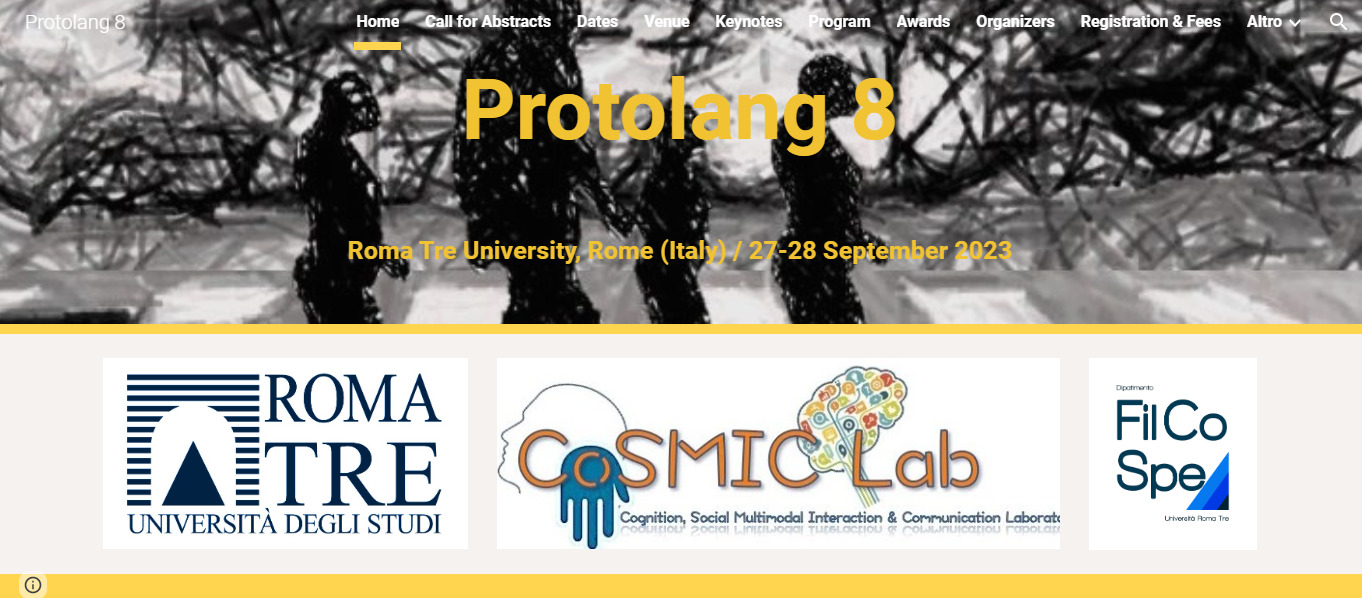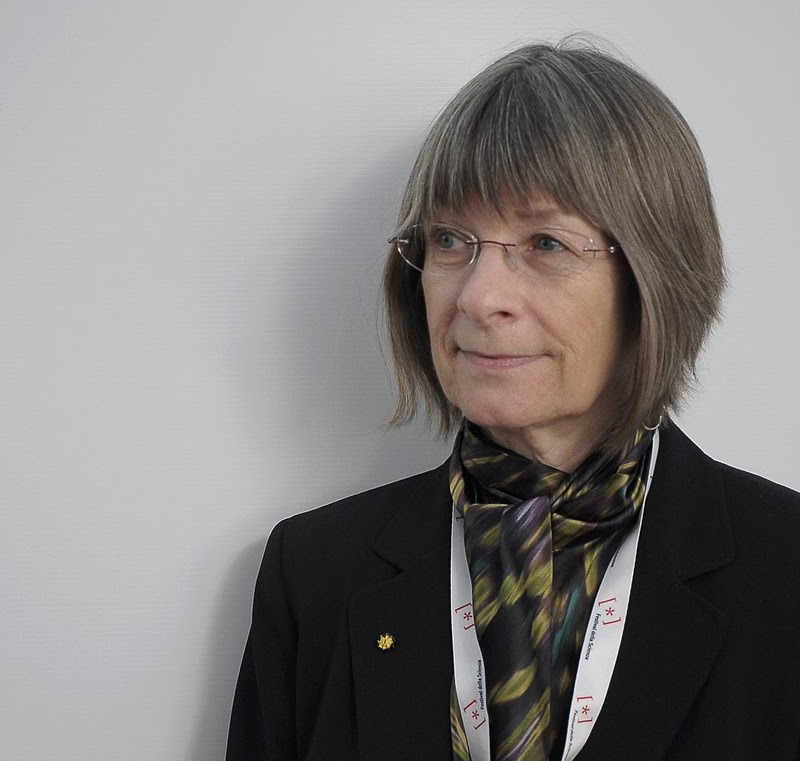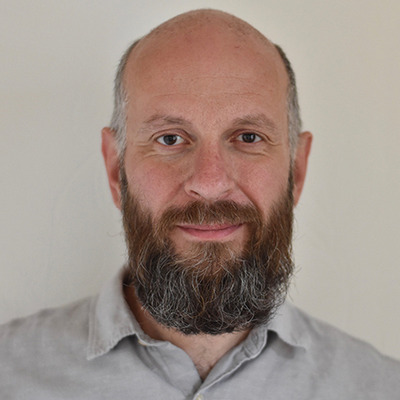On line il programma del convegno sull’evoluzione del linguaggio PROTOLANG 8 (Roma, 27-28 settembre 2023)

Il convegno sull’evoluzione del linguaggio Protolang 8 si terrà a Roma il 27 e 28 settembre, iscrizioni entro l’1 settembre
Il convegno PROTOLANG 8 si svolgerà il 27 e il 28 settembre 2023 presso il Dipartimento di Filosofia Comunicazione e Spettacolo dell’Università Roma Tre.
La serie di conferenze Protolang crea una piattaforma interdisciplinare per la discussione accademica sulle origini della comunicazione simbolica, distintiva degli esseri umani. L’obiettivo tematico di Protolang è delineare i requisiti genetici, anatomici, neuro-cognitivi, socio-culturali, semiotici, simbolici ed ecologici per l’evoluzione del (proto)linguaggio. L’uso dei segni, gli strumenti, l’allevamento cooperativo, il puntamento, la vocalizzazione, l’intersoggettività, la mimesi corporea, la pianificazione e la navigazione sono tra i molti possibili fattori attraverso i quali gli ominidi hanno acquisito un grado di specificità che non si trova in altre forme di comunicazione e cognizione animale. Miriamo a identificare le cause prossime e ultime, nonché i meccanismi attraverso i quali questi requisiti si sono evoluti; valutare le metodologie, gli strumenti di ricerca e le tecniche di simulazione; e consentire uno scambio di idee esteso al di là delle frontiere disciplinari.Si invitano gli studiosi da A (rcheology) a Z (oology), e tutte le discipline intermedie, a contribuire con dati, ricerche sperimentali e teoriche.
La deadline per le iscrizioni è l’1 settembre. Tutte le informazioni si trovano sul sito web del convegno
I relatori principali di Protololang8

Florida State University, Tallahassee, FL, USA
From Foot to Mouth: Keeping a Beat contributed to Musical and Linguistic Abilities in Hominins
Apes and monkeys have difficulty keeping time to perceived rhythms (auditory entrainment), which is an evolved ability that contributed to the universal emergence of dancing, drumming, singing, and playing musical instruments among humans. Motherese also incorporates the ability to entrain movement to sounds, but instead of being expressed by keeping time to nonlinguistic stimuli such as drumbeats, entrainment in motherese occurs when caretakers and infants adapt their vocal production to each other’s speech patterns (Ko et al. 2016). Motherese is of interest here because many believe its emergence likely paved the way for the invention of protolanguage, as it does for contemporary infants’ acquisition of language. Engaging in music and language involves many, but not all, of the same brain regions, consistent with the fact that the syntaxes of music and speech contain common elements that are essential for keeping a beat—namely, expectations/rules in listeners and producers about what is to come next in rapidly streaming sequences of sound, and when exactly it will occur (Doi and Masataka 2022, Fujii et al. 2014). In other words, the emergence of an ability to move in time to a beat was fundamentally important for the eventual evolution of both musical and linguistic abilities in hominins.
According to the “prenatal rhythmic experience” hypothesis (Larsson, Richter and Ravignani 2019), the ability to keep a beat arose during the evolution of bipedalism, as gaits of gestating females produced increasingly regularly spaced sounds and associated movements in the intrauterine environment. These sensations were simultaneously perceived through auditory and tactile senses by fetuses, thereby prompting the development of neurological connections that enhanced coordination between auditory and motor systems via synchronized neuronal oscillations. Consequently, hominins evolved a derived sense of rhythm that was seeded by entrainment of maternal footfalls to movements, which eventually contributed to the emergence of musical and dance skills.
Simultaneously, selection for bipedalism gradually modified feet to become weight-bearing instead of grasping organs. As a result hominin infants ceased to develop the ability to cling independently to their mothers, as all other higher primate infants do. This spinoff of bipedalism profoundly changed the physical attachment dynamics between mothers and infants, which likely contributed to the emergence of new kinds of reciprocal gestural and vocal communications that incorporated hominins’ evolving ability to entrain to rhythmic sounds. If so, bipedalism’s direct effects on hominin fetuses and infants kindled novel behaviors that were later exapted during the intertwined evolution of music, motherese, and protolanguage (Larsson and Falk, under review).
Palaeoanthropology, Institute for Archaeological Sciences & Senckenberg Centre for Human Evolution and Palaeoenvironment, Eberhard Karls University of Tübingen, Germany
Plasticity in great ape gesture: from individual- to species-level variation
Human language is an exceptionally plastic and productive signalling system. We can study the origins of our communicative innovativeness by examining the extent to which nonhuman species flexibly adjust their communication in response to the socio-ecological environment. Are the evolutionary roots of this plasticity to be found in our closest living relatives, the great apes? This hypothesis remains to be tested, because most comparative work focuses on population- or species-level variation rather than variation on the individual level. Long-term studies aimed at estimating the extent of plasticity in great apes’ communicative behaviour are inefficient, hence a more fruitful research avenue may be to compare individuals of the same species living in different populations or settings with different interaction partners and different social contexts. These contrasts allow a direct test of how repertoires respond to the relevant differences in the socio-ecological condition. In our recent research, we used a comparative sample of wild and zoo-housed orang-utans of two species (Pongo abelii, P. pygmaeus) to assess individual-, population- and species-level variation in communicative plasticity, focusing on gestural repertoires and repair (i.e. repetition and elaboration of initial gestures after communicative failure). We demonstrated that orang-utans facing more sociable and terrestrial conditions exhibit remarkable plasticity in their communicative behaviour. Because great apes are highly innovative in the non-communicative domain as well, this general plasticity may have facilitated language evolution in the hominin lineage.

Centre for Language Evolution, University of Edinburgh, UK
Cultural evolution builds linguistic systems
A striking feature of human language is the way it uses recombination of smaller parts to create larger signals, whether that be in the formation of morphemes out of meaningless phonemes, words out of morphemes, phrases out of words, or sentences out of phrases. Why is language constructed this way, and why is similar structure largely absent elsewhere in nature? In this talk, I will survey some recent experiments which demonstrate that a process of cultural evolution creates linguistic systems with this kind of structure. I will show across a range of modalities that an initial repertoire of holistic signals comes increasingly to be constructed out of reused parts as it is passed from one individual to the next by a process of iterated learning. This process mirrors what we see in real-world instances of language evolution such as in emerging sign languages. It is an inevitable consequence of the cultural process, even in cases where the holistic signals are more natural and are preferred by participants. I will show that this same process also creates the hallmark statistical structure of language: Zipfian distributions. The fact that language is learned and relearned every generation is both the cause and effect of these fundamental properties of linguistic structure.
University of Reading, UK
The Language Puzzle
How did we invent words, evolve language and talk our way out of the Stone Age?
The last three decades has seen new discoveries, insights and ideas in all disciplines relevant to our understanding of how language evolved, ranging from linguists to archaeology, genomics to psychology, and neuroscience to computer simulation. Old ideas about language centres in the brain and universal grammar have been discarded, and even older ideas about iconic words have been revived. We now appreciate the close interplay between biological and cultural evolution, one that remains on-going today as languages continues to evolve. The Language Puzzle provides a new synthesis of the interdisciplinary research, proposing how words were invented and language evolved from holistic phrases to strings of iconic words by 1.5 million years ago. By the time of the Neanderthals at 300,000 years ago, arbitrary words and syntactical structures had evolved, with a multiplicity of languages now present throughout the world. Metaphorical phrases and abstract words were added by Homo sapiens, creating the type of language we have today, one with which we talked our way out of the Stone Age.



